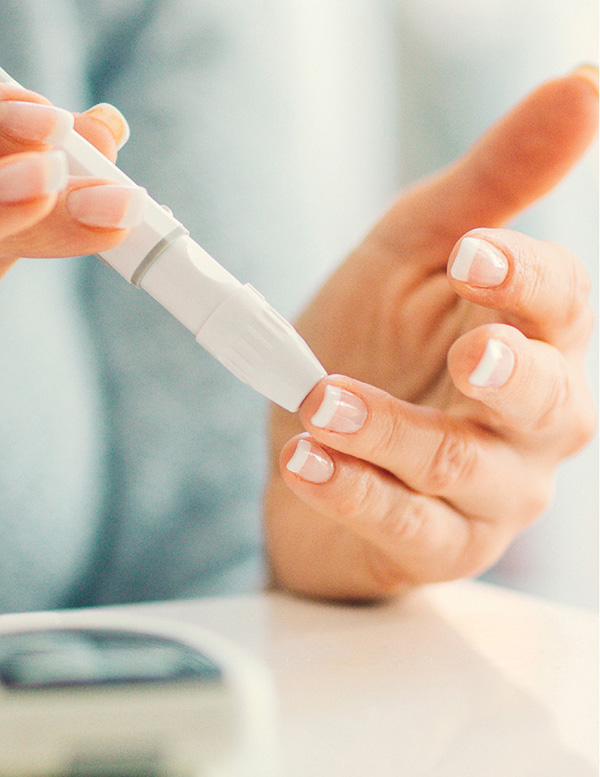Diabetes
It is a condition when the body is unable to maintain healthy levels of glucose in the blood. Diabetes occurs when little or no insulin is produced by the pancreas for glucose regulation.
There are three main types of diabetes:
There are three main types of diabetes:
Type 1 Diabetes
It is usually diagnosed in children or young adults. In type 1 diabetes, the pancreas no longer produces insulin and daily insulin injections are necessary.
Type 2 Diabetes
Usually found in people aged above 40 years who are overweight and have a sedentary lifestyle. Lifestyle management and oral medications are used in controlling the condition.
Gestational Diabetes
This occurs during pregnancy due to hormonal changes in the body. It needs to be managed due to the risk to the development of the unborn baby.
Type 2 diabetes is the most common type of diabetes. The brighter side of type 2 diabetes is that you can take steps to prevent or delay the development through lifestyle changes by maintaining a healthy lifestyle of exercises and watching your weight, etc.
Signs and symptoms
- Feeling thirsty despite drinking lots of water
- Urinating frequently, particularly at night
- Having blurred vision
- Feeling fatigue
- Weight loss
Risk Factors for Type 2 Diabetes
- 40 years and above
- Family history of diabetes
- High blood pressure
- Elevated levels of cholesterol
- History of gestational diabetes
- Overweight
- Sedentary lifestyle
Managing Diabetes
Requires a balance between healthy diet and regular exercise.
- Maintain a healthy body mass index (BMI) between 18.5 to 22.9
- Have regular meal timings
- Eat a balanced diet and avoid foods high in fats and salt
- Limit alcohol and sugar consumption
- Be active – exercise for at least 150 minutes a week
- Quit smoking
Possible Complications
High blood glucose levels can lead to complications in the body.
Common complications caused by uncontrolled diabetes can lead to:
- Kidney damage (nephropathy)
- Eye damage (retinopathy)
- Nerve damage (neuropathy)
- Cardiovascular disease
- Skin conditions
Self-Care Tips
- Monitor your blood pressure and cholesterol regularly
- Follow up with your doctor for regular assessments
- Protect and care for your feet daily
- Aim to keep blood glucose levels within target range
Risk of Low Blood Glucose
It is important to maintain your blood glucose within healthy levels as advised by your doctor. In some cases, patients may be too strict in maintaining the blood glucose or due to certain situations like missing meals or overdosing of medicines that lead to a dip in blood glucose levels.
Low blood glucose level (hypoglycemia) happens when blood glucose levels fall below 4mmol/L.
During this period, you may experience:
- An irregular heart rhythm
- Sweating
- Fatigue
- Hunger
- Pale Skin
- Irritability
- Shakiness
- Tingling sensation around the mouth
- Anxiety
All these symptoms are important in telling your family members, caregiver and you that the blood glucose level is low.
As hypoglycemia worsens, signs and symptoms may include:
Confusion, abnormal behavior or both, such as the inability to complete routine tasks
- Visual disturbances, such as blurred vision
- Seizures
- Loss of consciousness
One of the easy ways to remember how to help bring up your glucose level is via the ‘15-15 Rule’.
Have 15grams of carbohydrate and check your blood glucose level after 15 minutes. This will allow the body sufficient time to absorb the carbohydrate consumed.
The following food can provide you with approximately 15grams of carbohydrates:
- Half a cup (approximately 120ml) of fruit juice or soda
- 1 slice of bread
- Hard candies, jellybeans, or gumdrops – see food label for amount to consume
Repeat these steps until your blood glucose level is at least 4mmol/L. Once your blood glucose is back to normal, eat a meal or snack to make sure it does not lower again.










